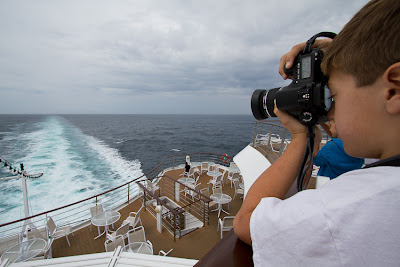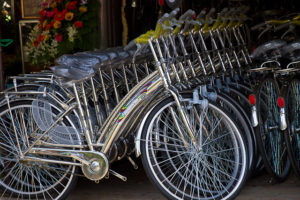Watching the Port of Boston slowly fade into the horizon was a bit odd. FInally being on board a moving ship was a new experience, and the sounds, movements and vibrations of the vessel are all new to me. Pilots develop a rather keen kinesthetic sense after years of flying, and I can feel and hear all sorts of subtle things that I have (technical) questions about. As we approached the continental shelf the seas definitely changed, and the next morning you could tell a few people weren’t quite their normal selves. Turning northeastbound to parallel the coast, the swell was pushing directly across the ship’s longitudinal axis, and a lot of people clearly weren’t fond of it, as telltale scopolamine ear patches became more commonplace. That being said, it wasn’t as bad as I thought, though I’m pretty sure the seas were fairly mild. The boys seem unaffected, though Reade is still sick with a cold.
 |
| The view out our 3rd deck cabin window. |
On the morning of the 23rd, we rounded the northern highlands of Cape Breton Island in Nova Scotia, but could only see a small island that lies 10 or so miles off Cape Breton. Nova Scotia holds a special place in my heart, as my Dad used to take us camping up there every other summer or so. We used to go on birdwatching hikes in Cape Breton National Park, picking fresh blueberries to eat the whole way. Fresh lobster brought back to Cheticamp Campground, all the small fishing villages, lobster traps, etc. SAS sometimes departs from Halifax, and I really wish they had for this voyage, it would have been fun to be back there.
We all got to meet Dr. Bernie Strenecky, one of the founders of The $100 Solution, the program that the boys will be part of a case study to evaluate the adaptation of the program to school-age children. Zubin Davar, the 25-year old Executive Director of the Board of the $100 Solution, approached the boys and asked them to sit in on meeting, and say a few words about what they are planning on doing. I spent about a half-hour with Reade and Tate preparing them for their first public speaking experience, and despite some fidgeting they did great! They seemed to enjoy interacting with Zubin, an SAS alumni who works in marketing in NYC. I’ll share much more about this endeavor as we near Chennai, India, where the boys will implement their $100 Solution.
 |
| Bit windy off of Nova Scotia! |
Reade and Tate have already started to make some friends amongst the other dependent children, and have been playing both basketball and ping pong, in addition to exploring the ship, learning all the nooks and crannies that remain elusive to us mere adults. Semester at Sea is using this leg to Montreal to host the Forum on Global Engagement, a lecture series concentrating on issues in globalization, this year’s forum focusing on Sino-U.S. relations. There are many Chinese participants on board in addition to some distinguished US lecturers (Ambassador J. Stapleton Roy, Jim McNerny, CEO of Boeing, etc.). Last night there was a traditional chinese music presentation, and the boys were very interested to see the unusual instruments that they played. One was sort of a vertical violin with a tin can-looking base, and another much like a hammer dulcimer.
Anyway, it’s currently 0925 on the 24th as we head toward the Saint Lawrence Seaway. We’ll be in Montreal tomorrow morning, and will be able to move into our permanent cabin and finally unpack, settle in. The chaos of the college students boarding will be interesting, however it will be one of SAS’s smallest student bodies, with only 451 students onboard (usually there are upwards of 700). As I’ve learned in a few presentations over the last few days, the economy has understandably presented the Institute for Shipboard Education new challenges, but they are trying to adapt to keep this non-profit organization ‘afloat’ (ahem!). Having been founded in 1963, traditionally the fall and spring semester voyages have always circumnavigated the globe, but after this voyage the fall voyages will be Atlantic explorations only. Fuel costs are currently about $2000/hour to run the ship (which ISE owns), and declining enrollments start to paint a ‘perfect storm’ sort of picture that casts shadows on this amazing program. Some colleges and universities continue to refuse to accept SAS coursework for credit, despite the academic sponsor being the very well-respected University of Virginia. Many colleges want study abroad for their students to be ‘immersion’ experiences, and they cannot fathom how seeing 14 countries in 111 days ‘on a cruise ship’ could provide such an opportunity. Not having yet been on a voyage I still disagree–knowing Heidi–and now having talked with many SAS alumni (and reading dozens of student blogs preparing for the trip) for which SAS was truly a catalyst in their lives, much different than the experience of your typical Spain or Italy study abroad student. If any of you out there have children nearing college-age and are considering study abroad programs, might I suggest that you find out whether or not the schools they are looking at accept credit from SAS, and seriously consider SAS for their study abroad experience. I know that Heidi’s experience during her Fall 1988 voyage shaped her life in ways that she might not have been able to envision at the time, and the ‘kids’ I’ve talked to only three days into our experience are similarly changed individuals. I’ll certainly speak more to this as the voyage progresses, as I think we all are starting to realize that globalization of the economies of the world is happening whether the U.S. likes it or not, and the kids who have international education experience will have a leg up on their competition.
 |
| SAS Liferaft, anyone? |
Anyway, the seas have calmed, and the MV Explorer will spend the night navigating the waters of the St. Laurence while we are sleeping. We will awaken as the ship prepares to dock and let the forum-goers debark, while hundreds of college students await finally beginning their journey around the world, as we did a mere 3 days ago.





